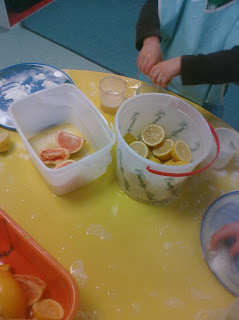#1: Drizzle painting: for this I gave them three containers of tempera paint with pipettes. I used powdered tempera mixed to a consistency thick enough to stick to the paper towels, but thin enough to run down the paper.
This girl was particularly interested in how high up on the paper she could put the paint and get it to still drip on the floor. (Process!)
The girl who made this painting was persistently trying to make vertical lines; she said to me, in only a slightly exasperated voice, "even when I make lines across, they still drip down."
#2: Color mixing. This activity is pretty self explanatory, but I cannot say enough about it. They loved this activity (boys too) and created some fantastic shades. See at the end of this section for a Bev Bos video that inspired it.
video:
#3: Dough Paint: I found this in the Science Arts book. The paint is made of equal parts salt, flour, and water, with a little paint added. The book calls is "Sparkle Dough Paint," but I wouldn't say it actually "sparkles." None the less it is a fun art activity. They helped me funnel it into squeeze bottles and off they went.
Most of them chose to do "fold over" paintings, I did not suggest it, but one child did it and it caught on like wildfire. (The term "Fold Over Painting" is borrowed from Bev Bos.
I love the one above. It took forever to dry (three days) but I thought it was such a creative use of the materials.
I love how this one (above) was folded at an angle to make an interesting shape.
#4: Salad Spinner Art: This is one of everyones' favorite ways to paint at school. All it takes is some precut paper, some liquid water colors, pipettes, and a salad spinner. Like most of these painting options- no instructions are needed.
Add as much or as little paint as desired.
Spin for as long and and as fast as desired.
Ta- Da!
#5: Bubble Painting: Some children a little older than my class did this project and was fascinated by making really cool designs on their paper with the over flowing bubbles but my class wasn't really interested in what was happening to their paper. They were interested in what was happening in the cup: the bubbles building, the bubbles overflowing, the bubbles popping. This being said, we switched from paper to paper towels so we could do more bubbles faster and clean up faster.
#6: Incline Painting (with cars and marbles!): This activity was inspired by one of my favorite blogs: Teacher Tom's Blog. Now, mine was not as complex as Teacher Tom's, but I am not a builder, or a "tinkerer" or anything of the sort.
My simple solution was to adjust only one side of our adjustable table. I put a sensory pan at the bottom to catch the cars and left the roll of paper on the floor by the legs, pulling the paper over the top and cutting it off for the next group.
This was pretty fun, and kept the boys interest for more than ten minutes!


























































